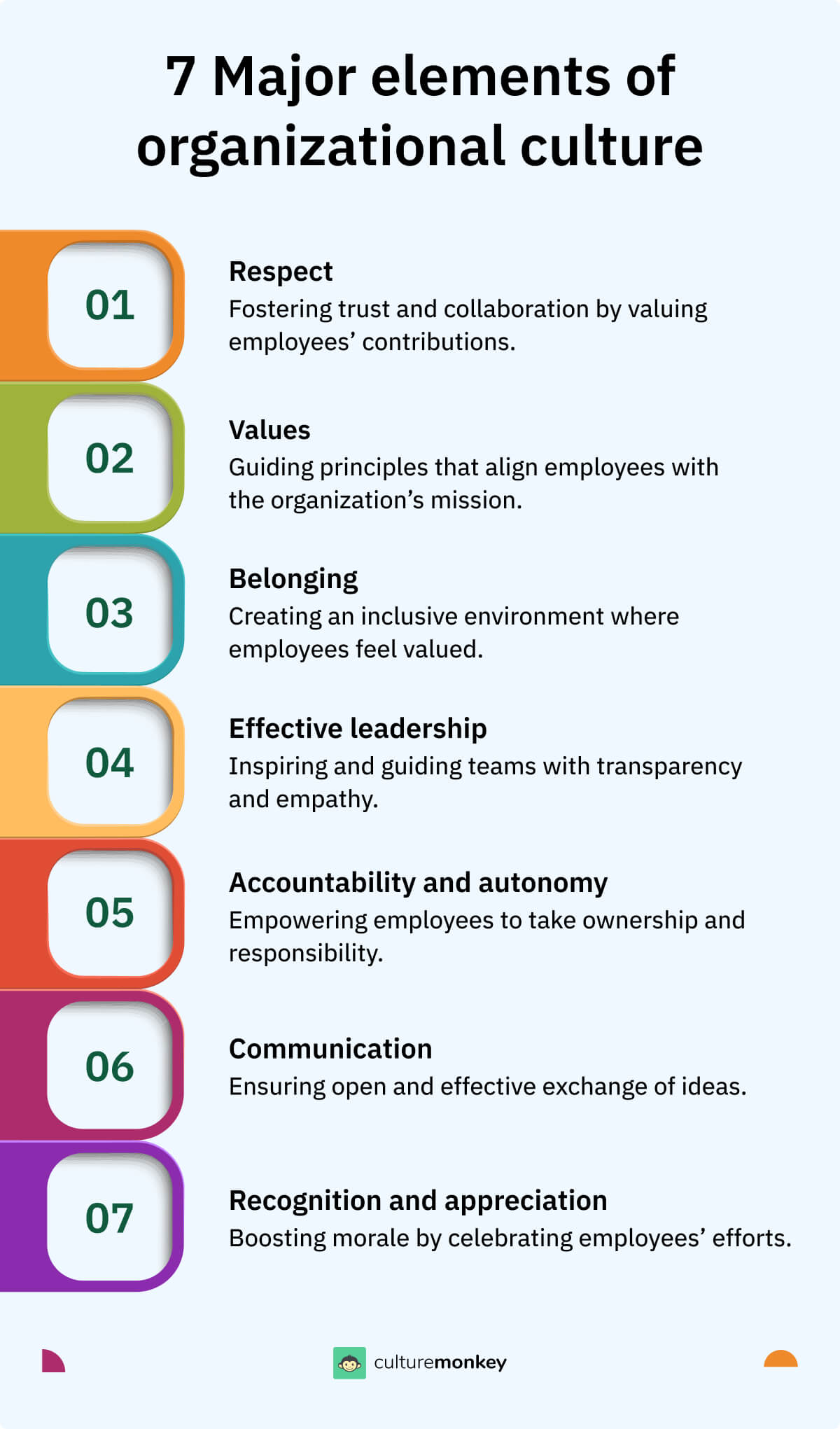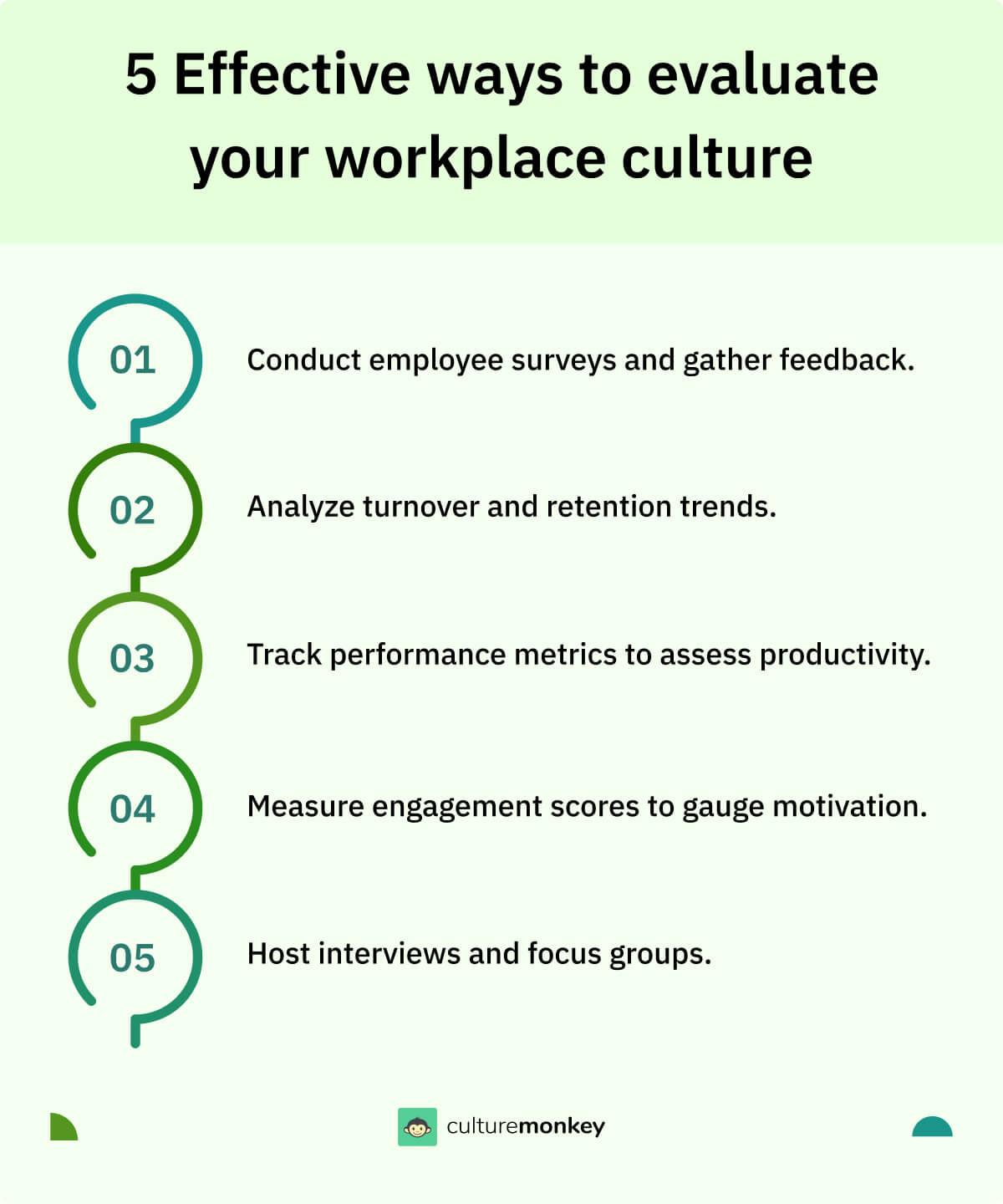What are the 7 key elements of company culture you should know in 2025

Imagine running a top-tier restaurant kitchen. You have award-winning chefs, the freshest ingredients, and cutting-edge kitchen equipment. But if the line cooks don’t communicate, the plating isn’t consistent, and the timing is off, even the best recipes can turn into chaos. A successful kitchen thrives on coordination, mutual respect, and a shared commitment to excellence—without them, it’s just a noisy, disorganized mess.
Success isn’t just about hiring top talent; it’s about creating an environment where they can thrive. That’s where the elements of workplace culture come in. A strong workplace culture isn’t built overnight. It’s a blend of values, behaviors, and practices that shape how your team interacts, collaborates, and grows together.
Get it right, and you’ll have an engaged, motivated workforce driving your business forward. Get it wrong, and you risk high turnover, disengagement, and missed opportunities.So, what does it take to build a culture that fuels workplace success in 2025?
Let’s break down the seven key elements of culture - what they are, why they matter, and how they can transform an organization into a thriving ecosystem for success.
Blog Highlights


What is workplace culture?

Workplace culture refers to the shared values, beliefs, attitudes, and behaviors that define how employees interact and collaborate within an organization. It is the invisible fabric that shapes the overall environment, influencing everything from communication patterns to decision-making processes. A strong workplace culture aligns with the organization's mission and vision, creating a sense of purpose and unity among employees.
It encompasses elements such as leadership style, employee engagement, inclusivity, recognition, and how conflicts are managed. Workplace culture also dictates unwritten rules—norms that guide day-to-day interactions and expectations.
A positive culture fosters trust, collaboration, and innovation, attracting top talent and boosting retention. Conversely, a toxic culture can lead to disengagement, high turnover, and inefficiency. Ultimately, workplace culture is the backbone of organizational success, directly impacting employee satisfaction, performance, and the ability to adapt to changing business landscapes.
Why is a good workplace culture important?

A good workplace culture is the foundation of a thriving organization. It goes beyond surface-level perks like casual Fridays or free coffee; it reflects how employees feel, communicate, and collaborate daily.
When workplace culture is positive, it fosters a sense of belonging and motivates employees to give their best, directly impacting productivity and innovation. Here’s why a good workplace culture is crucial:
- Boosts employee engagement: Employees in a supportive culture are more engaged and committed to their work, leading to higher productivity and job satisfaction.
- Enhances teamwork and collaboration: A positive culture fosters trust and open communication, encouraging teams to work together harmoniously toward common goals.
- Attracts and retains top talent: Companies with a strong culture stand out as desirable employers, making it easier to attract and retain skilled professionals.
- Improves overall performance: A good culture aligns employees with the organization’s objectives, ensuring efficiency and driving business success.
- Encourages adaptability and innovation: A positive culture embraces change and empowers employees to experiment and innovate, keeping the organization competitive.
What are the 8 functions of organizational culture?

Organizational culture serves several functions within a company, influencing how individuals and teams operate. The eight primary functions of organizational culture are:
1. Identity and unity
- Function: Organizational culture provides a sense of identity and unity among members of the organization. It establishes a shared understanding of who the organization is, what it stands for, and what distinguishes it from others.
- Impact: This function helps create a cohesive and unified workforce, fostering a sense of belonging and pride among employees. A strong organizational identity can align individuals toward common goals and values.
2. Social glue
- Function: Culture acts as a social glue that binds people together. It establishes a set of norms, values, and shared experiences that create a common ground for communication and interaction among employees.
- Impact: By fostering a sense of community and shared purpose, organizational culture promotes collaboration, teamwork, and effective communication. It helps create a supportive environment where individuals can work together harmoniously.
3. Guide for behavior
- Function: Organizational culture serves as a guide for behavior within the organization. It communicates the expected norms, values, and acceptable ways of interacting, making it clear how employees should conduct themselves in various situations.
- Impact: This function helps minimize ambiguity and uncertainty, providing employees with a framework for decision-making and actions. It contributes to a more stable and predictable work environment.
4. Means of control and stability
- Function: Culture functions as a mechanism for control and stability within the organization. It influences employee behavior by shaping their attitudes, values, and beliefs, which, in turn, impact how work is performed and objectives are pursued.
- Impact: By providing a set of shared values and expectations, organizational culture contributes to the stability of the organization. It helps align individual and group efforts with the overall mission and goals, ensuring a degree of consistency in how work is conducted.



Culture is not an initiative. Culture is the enabler of all initiatives.
Founder
Senn Delaney Culture Shaping, Heidrick Consulting
5. Enhancing employee engagement
- Function: Organizational culture plays a crucial role in enhancing employee engagement. By fostering an environment where employees feel valued and understood, culture can drive higher levels of involvement and commitment.
- Impact: Engaged employees are more likely to be productive, motivated, and aligned with organizational objectives, leading to improved performance and reduced turnover.
6. Facilitating change and innovation
- Function: A strong organizational culture can facilitate change and innovation by encouraging adaptability and open-mindedness. It supports a mindset where continuous improvement and creative problem-solving are valued.
- Impact: This function enables the organization to stay competitive and responsive to market changes, fostering an environment where new ideas are welcomed and explored.
7. Building organizational reputation
- Function: Organizational culture significantly influences the external perception of a company. A positive and strong culture can enhance the organization’s reputation among customers, partners, and potential employees.
- Impact: A good reputation attracts top talent, loyal customers, and trustworthy partners, contributing to long-term success and sustainability.
8. Supporting strategic alignment
- Function: Organizational culture ensures that the behaviors and attitudes of employees are aligned with the strategic goals of the company. It reinforces the strategic direction and helps in the execution of business strategies.
- Impact: By aligning culture with strategy, organizations can improve efficiency, focus efforts on achieving key objectives, and enhance overall performance.
Why should you be aware of the elements of company culture in the first place?

Understanding the elements of company culture is paramount in navigating the complex landscape of today's professional world. Firstly, company culture shapes the environment and social and physical worlds in which you work, influencing the overall atmosphere, values, and expectations.
By being aware of these elements, you gain insight into the underlying dynamics that impact your day-to-day experiences and interactions with colleagues.
Moreover, awareness of company culture's basic beliefs is crucial for personal alignment and professional fulfillment. A culture that resonates with your values and work style can enhance job satisfaction and motivation.
Conversely, a misalignment may lead to disengagement and dissatisfaction. Recognizing the elements allows you to assess whether the organization's ethos aligns with your personal and professional aspirations.
Beyond personal fulfillment, an understanding of company culture is vital for career success. It informs how decisions are made, how innovation is valued, and how leadership operates.
Being attuned to these nuances empowers you to navigate the organizational landscape more effectively, positioning yourself for growth and advancement.
Furthermore, in an interconnected world where collaboration is key, awareness of company and culture norms facilitates effective teamwork. It enables you to comprehend the unwritten rules, communication patterns, and expectations, fostering better collaboration and reducing misunderstandings.
In essence, awareness of the elements of company culture is not just a nicety; it's a strategic necessity.
It empowers individuals to thrive in their professional environments, make informed career choices, and contribute meaningfully to the success of their organizations.
What are the 7 major elements of organizational culture?

Organizational culture is the invisible force that shapes how people within a company work, interact, and achieve shared goals. It defines the company’s personality and creates the foundation for its success. Below are the seven major elements of organizational culture that contribute to building a thriving and productive workplace.
Respect
Respect is the cornerstone of any positive organizational culture. It involves valuing the contributions, perspectives, and individuality of every employee. When respect is ingrained in workplace interactions, it creates an environment where people feel safe to express their ideas, concerns, and creativity.
A respectful culture reduces workplace conflicts, fosters collaboration, and builds trust among employees. Organizations that prioritize respect also see higher employee morale and stronger working relationships, enabling teams to function harmoniously and perform at their best.
Values
Values are the guiding principles that define an organization’s identity and priorities. They inform decision-making, employee behavior, and the overall direction of the company. Well-defined values act as a compass, ensuring that everyone in the organization is aligned with its mission and vision.
When values are clearly communicated and consistently upheld, they strengthen the organization’s credibility and create a sense of purpose among employees. A value-driven culture inspires employees to act with integrity and fosters a cohesive, goal-oriented workforce.
Belonging
A sense of belonging is crucial for creating an inclusive and supportive work environment. It’s about making every employee feel connected to the organization’s mission and valued for their unique contributions. A culture of belonging encourages diversity and ensures that everyone feels like they have a place at the table.
Employees who experience belonging are more engaged, motivated, and productive. They tend to form stronger connections with their colleagues and are more likely to stay committed to the organization, contributing to long-term success. At this stage, many companies engage company culture consultants to help shape and refine belonging initiatives, ensuring inclusivity is not just a value, but a practiced norm.
Effective leadership
Leadership plays a pivotal role in shaping and sustaining organizational culture. Effective leaders set the tone by modeling the values and behaviors they expect from their teams. They foster trust by being approachable, empathetic, and transparent in their communication and decision-making.
Great leaders not only provide clear direction but also inspire employees to grow and excel. They cultivate a sense of purpose within the organization, ensuring that everyone feels aligned with the company’s goals and motivated to contribute their best efforts.
Accountability and Autonomy
A balance between accountability and autonomy is essential for a high-performing organizational culture. Accountability ensures that employees take ownership of their responsibilities and deliver on their commitments. Managers play a critical role in fostering this culture.
At the same time, autonomy empowers individuals to make decisions and contribute meaningfully without constant oversight.When employees are trusted to manage their work, they feel valued and motivated. This balance fosters innovation, improves job satisfaction, and creates an environment where people are encouraged to take initiative and solve problems effectively.
Communication
Communication is the lifeblood of a healthy organizational culture. Transparent and open communication ensures that employees are informed about company goals, expectations, and developments. It also provides a platform for employees to voice their opinions and concerns.
Effective communication reduces misunderstandings, builds trust, and promotes collaboration across teams. Organizations that prioritize communication foster a culture of inclusion, where every employee feels heard and valued, enhancing overall productivity and engagement.
Recognition and Appreciation
Recognition and appreciation are powerful motivators in any workplace. Acknowledging employees’ contributions, whether through formal rewards or simple words of gratitude, boosts morale and fosters a culture of excellence.
Employees who feel appreciated are more likely to remain loyal, engaged, and motivated to go the extra mile. A workplace that regularly celebrates achievements cultivates a sense of pride and encourages continuous improvement, strengthening the overall organizational culture.
Signs of good and bad organizational culture

A positive organizational culture can lead to high employee satisfaction, increased productivity, and sustained business growth, while a negative culture can result in low morale, high turnover, and poor performance. Understanding the signs of both good and bad organizational culture is essential for leaders and managers who aim to create and maintain a healthy workplace.
Signs of good organizational culture
- High employee engagement: Employees are motivated, enthusiastic, and invested in their work. High levels of employee experience and engagement indicate a positive work environment where employees feel valued and recognized.
- Open communication: Transparent and open communication channels exist at all levels. Employees feel comfortable sharing ideas, feedback, and concerns, fostering a strong culture of trust and collaboration.
- Strong leadership: Leaders are approachable, supportive, and exhibit integrity. They inspire their teams, set clear expectations, and provide regular feedback, contributing to a positive organizational culture.
- Collaborative environment: Teamwork strong communication and collaboration are highly valued. Cross-functional teams work well together, leveraging diverse skills and perspectives to achieve common goals, indicating a healthy organizational culture.
- Continuous learning and development: The organization prioritizes ongoing learning and professional development. . Employees expect to have access to training programs, mentorship, and opportunities for growth, reflecting a culture of continuous improvement.
- Recognition and reward: Employees' contributions are regularly recognized and rewarded. Acknowledgment of hard work and achievements boosts morale and encourages a culture of excellence and high performance.
- Work-life balance: The organization supports a healthy work-life balance. Flexible work arrangements and policies that promote well-being are in place, leading to higher job satisfaction and lower turnover rates.



Culture is about performance and making people feel good about how they contribute to the whole.
Operating Partner
Gridiron Capital LLC
Signs of bad organizational culture
- High turnover rate: Frequent employee turnover suggests dissatisfaction and poor workplace conditions. It indicates underlying issues such as lack of engagement, inadequate recognition, or poor management.
- Poor communication: There is a lack of transparency and open communication. Employees feel left out of important conversations, leading to misunderstandings, misinformation, and a lack of trust.
- Toxic leadership: Leaders exhibit authoritative, unapproachable, or unethical behavior. This creates a fearful and oppressive work environment, resulting in low morale and disengagement.
- Lack of collaboration: Siloed departments and a lack of teamwork are prevalent. Poor collaboration hinders innovation, efficiency, and the overall effectiveness of the organization.
- Resistance to change: The organization's culture is resistant to change and innovation. Stagnation and reluctance to adopt new ideas or technologies indicate an inflexible and outdated culture.
- Absence of recognition: Employees' efforts and achievements go unnoticed. A lack of recognition and rewards leads to low motivation, reduced productivity, and feelings of being undervalued.
- Poor work-life balance: Employees are overworked and stressed, with little regard for personal well-being. This results in burnout, decreased job satisfaction, and increased absenteeism.
Understanding organizational culture elements to strategize a relevant culture

Crafting a strategic and relevant organizational culture involves thoughtful consideration of various elements that collectively shape the society's material culture and work environment. Here's how understanding these elements can guide the strategic development of a company's culture:
Assessment of current culture
Understanding the existing elements of organizational culture allows leaders to assess the current state. This assessment identifies strengths to be preserved and areas requiring improvement. It serves as a foundation for strategic planning.
Defining core values and mission
By identifying the core values that resonate with both the organization's mission and the aspirations of many such societies and their members, leaders can articulate a clear vision. These values act as guiding principles, shaping behaviors and decision-making at all levels.
Leadership alignment
Recognizing the impact of leadership on culture enables strategic alignment. Leaders can model behaviors that reflect the desired culture, creating a top-down influence. Leadership development programs can be tailored to reinforce cultural values.
Communication strategy
Knowing the importance of communication patterns in shaping culture allows for the development of a targeted communication strategy. Transparent and open communication about the desired culture ensures that the entire organization is on the same page.
Employee involvement and recognition programs
Acknowledging the significance of employee recognition and engagement, leaders can design programs that celebrate achievements in alignment with cultural values. This involvement fosters a sense of ownership and commitment among employees.
Adaptability and innovation initiatives
Recognizing the need for adaptability and innovation within a dynamic business landscape, organizations can instill a culture that encourages experimentation, learning from failures, and staying abreast of industry trends.
Inclusivity and diversity initiatives
Understanding the impact of inclusivity and diversity on a society's culture also allows for the implementation of initiatives that foster an inclusive workplace. This may include diversity training, mentorship programs, and policies that promote equal opportunities.
Work-life balance strategies
Awareness of the importance of work-life balance in shaping culture informs the development of strategies that support employee well-being. Flexible work arrangements, wellness programs, and policies that prioritize work-life harmony contribute to a positive culture.
Continuous learning programs
Recognizing the role of continuous learning in a progressive culture, organizations can invest in learning and development programs. These initiatives ensure that employees are equipped with the skills needed to contribute to the organization's success.
Measuring and adapting
Regularly measuring the effectiveness of cultural initiatives allows leaders to adapt and refine their strategies. Feedback mechanisms, surveys, and key performance indicators aligned with cultural goals provide insights for continuous improvement.
Sustainability and social responsibility
Understanding the growing importance of sustainability and social responsibility in modern culture, organizations can integrate these values into their strategic culture development. This includes implementing environmentally friendly practices and engaging in community outreach programs.
Technology integration
Recognizing the role of technology in shaping modern work culture, organizations can strategically incorporate technological advancements to enhance productivity and collaboration. This includes adopting digital tools and platforms that facilitate efficient communication and workflow.
In essence, understanding the elements of organizational culture equips leaders with the insights needed to strategically shape and reinforce a culture that aligns with the organization's vision, values, and objectives.
By intentionally focusing on these elements, leaders can foster a workplace environment that not only attracts top talent but also propels the organization toward sustained success.

Retain Top Talent with
Thriving Workplace Culture
Strengthen your workplace culture to create an environment of purpose, growth, and excellence.
Measuring the impact of organizational culture on employee engagement and performance

Measuring the effectiveness of organizational culture in driving employee engagement and overall performance is essential for maintaining a productive and motivated workforce. Here are nine methods to evaluate this effectiveness
1. Employee surveys and feedback
Regular employee surveys provide valuable insights into the workforce's sentiment and engagement levels. Surveys should include questions about job satisfaction, recognition, communication, leadership, and work environment. Anonymous employee feedback can encourage honesty and reveal areas needing improvement.
2. Employee turnover and retention rates
High employee turnover can indicate cultural issues within the organization. Analyzing retention rates helps identify trends and underlying causes of employee dissatisfaction. Low turnover rates typically signify a positive organizational culture that supports and engages its employees.
3. Performance metrics
Reviewing key performance indicators (KPIs) such as productivity, quality of work, and achievement of targets can reflect the impact of organizational culture on performance. Consistently high performance and goal attainment suggest an effective and supportive culture.
4. Employee engagement scores
Engagement surveys specifically designed to measure employee engagement levels can highlight how connected highly engaged employees feel to their work and the organization. High engagement scores are indicative of a strong, positive culture that motivates employees.
5. Qualitative interviews and focus groups
Conducting in-depth interviews and focus groups with employees can provide a deeper understanding of their experiences and perceptions of the organizational culture. These discussions can uncover nuanced issues and areas for cultural improvement that surveys might miss.
6. Absenteeism rates
Frequent absenteeism can signal disengagement and dissatisfaction among employees. Monitoring absenteeism rates helps assess the overall well-being and morale of the workforce. Low absenteeism is often a sign of a healthy organizational culture.
7. Recognition and reward systems
Evaluating how often and effectively employees are recognized and rewarded for their contributions can indicate cultural health. A robust recognition system that acknowledges employee achievements promotes engagement and enhances performance.
8. Employee development and career progression
Tracking the opportunities for employee to support professional development, and career advancement can show how the organizational culture supports growth and learning. High rates of internal promotions and professional development participation suggest a culture that values and invests in its employees.
9. External benchmarking
Comparing your organizational culture and engagement metrics with industry standards or best practices can provide context and highlight areas for improvement. Benchmarking against similar organizations helps gauge where your culture stands relative to competitors.
The importance of company culture in attracting and retaining talent

A strong culture is a defining factor for both attracting top talent and enhancing employee retention. More than perks, it reflects the organization's values, fostering a positive workplace culture and shaping the overall employee experience.
A positive work environment aligned with the organization's values draws candidates who seek purpose and alignment. Job seekers increasingly prioritize workplaces with a great corporate culture, characterized by inclusivity, collaboration, and growth. When prospective employees recognize opportunities for meaningful contributions and positive employee experiences, they are more inclined to join an organization that mirrors their professional aspirations.
Retention is equally tied to company culture. Employees who feel supported, valued, and connected to the organization’s mission are more engaged and committed. Culture fosters trust, enhances communication, and builds loyalty, reducing turnover rates. On the other hand, a toxic or misaligned culture leads to disengagement, burnout, and high attrition.
Organizations that improve organizational culture by emphasizing clear communication, inclusivity, and recognition create a positive work environment that supports long-term engagement. Employees who experience this thrive, staying committed to a shared vision. Ultimately, a strong culture is the heartbeat of an organization’s ability to enhance both talent acquisition and employee retention.
How CultureMonkey helps to build a strong workplace culture
Workplace culture is the foundation of any thriving organization. A strong culture inspires trust, collaboration, and innovation, creating an environment where employees feel empowered to contribute their best.
CultureMonkey offers tools designed to help organizations build and sustain such a culture by turning employee feedback into actionable insights.
- Employee engagement surveys: CultureMonkey’s customisable surveys are designed to capture authentic employee sentiments by aligning with organizational goals. Backed by people science, these surveys identify cultural strengths and gaps, helping leaders focus on what truly matters to their workforce and drive meaningful change.
- Real-time feedback analytics: Leaders can instantly visualize employee engagement trends and uncover patterns that influence workplace dynamics. This data-driven approach allows organizations to prioritize areas with the greatest impact on employee satisfaction and productivity, leading to informed decision-making.
- Multilingual surveys: Ensuring inclusivity across diverse teams, CultureMonkey’s multilingual surveys allow employees to share feedback in their preferred language. This fosters a culture of belonging, making employees feel valued and heard, regardless of their background.
- AI-powered action recommendations: CultureMonkey provides tailored recommendations based on employee feedback, guiding leaders in addressing challenges effectively. This enables decisive actions that drive meaningful cultural improvements and create a positive, supportive work environment.
- Comprehensive manager dashboards: Managers gain valuable insights into their teams' engagement levels, helping them identify concerns early, strengthen relationships, and encourage collaboration. This empowers managers to foster a more engaged and motivated workforce.
Conclusion
A strong workplace culture is the cornerstone of organizational success. It fosters collaboration, trust, and a shared sense of purpose, enabling employees to thrive both individually and collectively.
When culture prioritizes respect, inclusivity, and clear communication, it creates an environment where innovation flourishes and challenges are met with confidence. Investing in workplace culture is not just about improving employee morale; it’s about building a resilient and adaptable organization.
By understanding and nurturing the key elements of culture—such as leadership, recognition, and engagement—businesses can inspire loyalty, drive productivity, and achieve sustainable growth. A thriving culture isn’t a luxury—it’s a necessity. Organizations that embrace it are better positioned for long-term success.
CultureMonkey empowers organizations to create a workplace culture where employees and businesses thrive together. Take the first step toward a thriving workplace—explore CultureMonkey now!
Summary
A strong company culture is the foundation of a thriving and productive workplace. It shapes how employees interact, collaborate, and align with the organization’s mission and values. Understanding the key elements of workplace culture—such as respect, values, belonging, leadership, and communication—helps businesses create an environment that fosters engagement and motivation.
A well-defined culture promotes teamwork, accountability, and adaptability, enabling organizations to navigate challenges and achieve long-term success.
FAQs
1. Why is culture important?
Culture is vital because it shapes the work environment and influences how employees interact, collaborate, and feel about their workplace. A strong organizational culture fosters a sense of belonging, aligning employees with the company's values and mission. This sense of belonging enhances job satisfaction, motivation, and overall performance, contributing to the organization's success.
2. How can the culture of an organization contribute to overall employee satisfaction?
A positive organizational culture promotes trust, respect, and inclusivity, making employees feel valued and connected. When these strong cultures make employees feel they belong, they are more likely to be satisfied with their job, exhibit higher engagement, and stay committed to the organization. This satisfaction leads to increased morale, productivity, and retention rates, creating a more stable and motivated workforce that drives organizational success.
3. Why is a good company culture important?
A good company culture is crucial because it creates an environment where employees feel supported, respected, and appreciated. This sense of belonging boosts morale, encourages collaboration, and enhances job satisfaction. Employees who feel part of a positive corporate culture are more motivated, engaged, and likely to contribute to the company's success, fostering a productive and harmonious workplace.
4. How do these elements influence workplace dynamics?
The elements of organizational culture, such as values, norms, and communication patterns, shape workplace dynamics by fostering a sense of belonging. When organizations engage employees who share common values and practices, they are more likely to collaborate effectively, resolve conflicts amicably, and work towards common goals. This shared understanding enhances overall harmony, increases productivity, and creates a more cohesive and supportive work environment.
5. Can understanding the 7 elements of culture help in conflict resolution?
Yes, understanding the 7 elements of culture can aid in conflict resolution by promoting a sense of belonging. Recognizing shared values, norms, and communication styles helps employees address misunderstandings and disagreements constructively. This shared understanding fosters a collaborative environment, making it easier to find mutually acceptable solutions and maintain workplace harmony.
6. Do these cultural elements change over time?
Yes, cultural elements can evolve over time as the organization grows and adapts to new challenges. Changes in leadership, market conditions, strategic investments, and workforce demographics can influence these elements. Maintaining a sense of belonging during these transitions is crucial for sustaining employee engagement, satisfaction, and a positive organizational culture, ensuring employees feel connected and valued amidst changes.
7. How can you keep the components of organizational culture adaptable?
To keep the components of organizational culture adaptable, regularly assess and update cultural elements based on feedback and industry trends. Encourage continuous learning and open communication, fostering an environment where innovation and flexibility are valued across different cultures. Implement change management practices to smoothly integrate new initiatives, ensuring the ideal culture evolves in alignment with organizational goals and external changes.
8. Which cultural element refers to the unwritten rules, norms, and behaviours that guide interactions within an organization?
The cultural element encompassing unwritten rules, norms, and behaviors that guide interactions within an organization is known as "organizational culture." It includes the informal standards and shared beliefs that influence daily employee interactions and decision-making processes, ensuring a harmonious and aligned work environment consistent with the organization's overarching values and goals.




